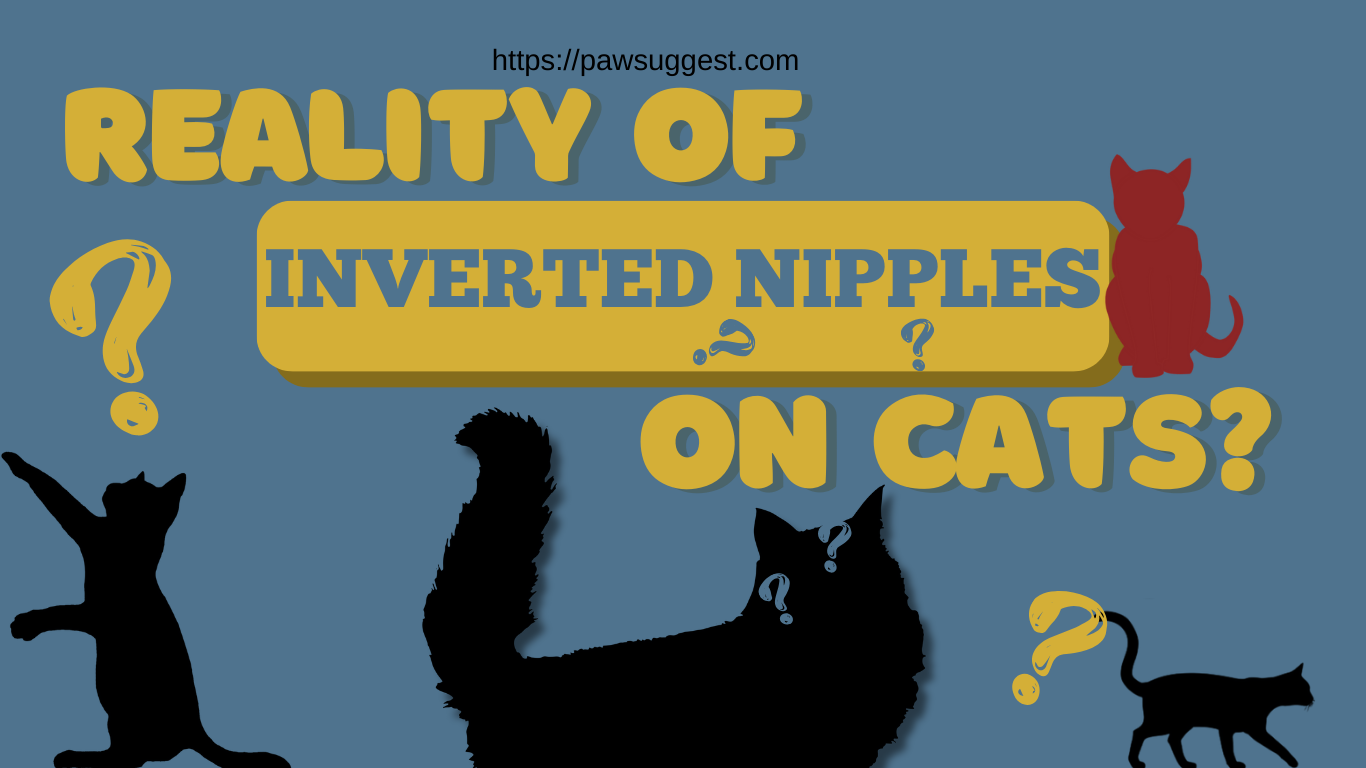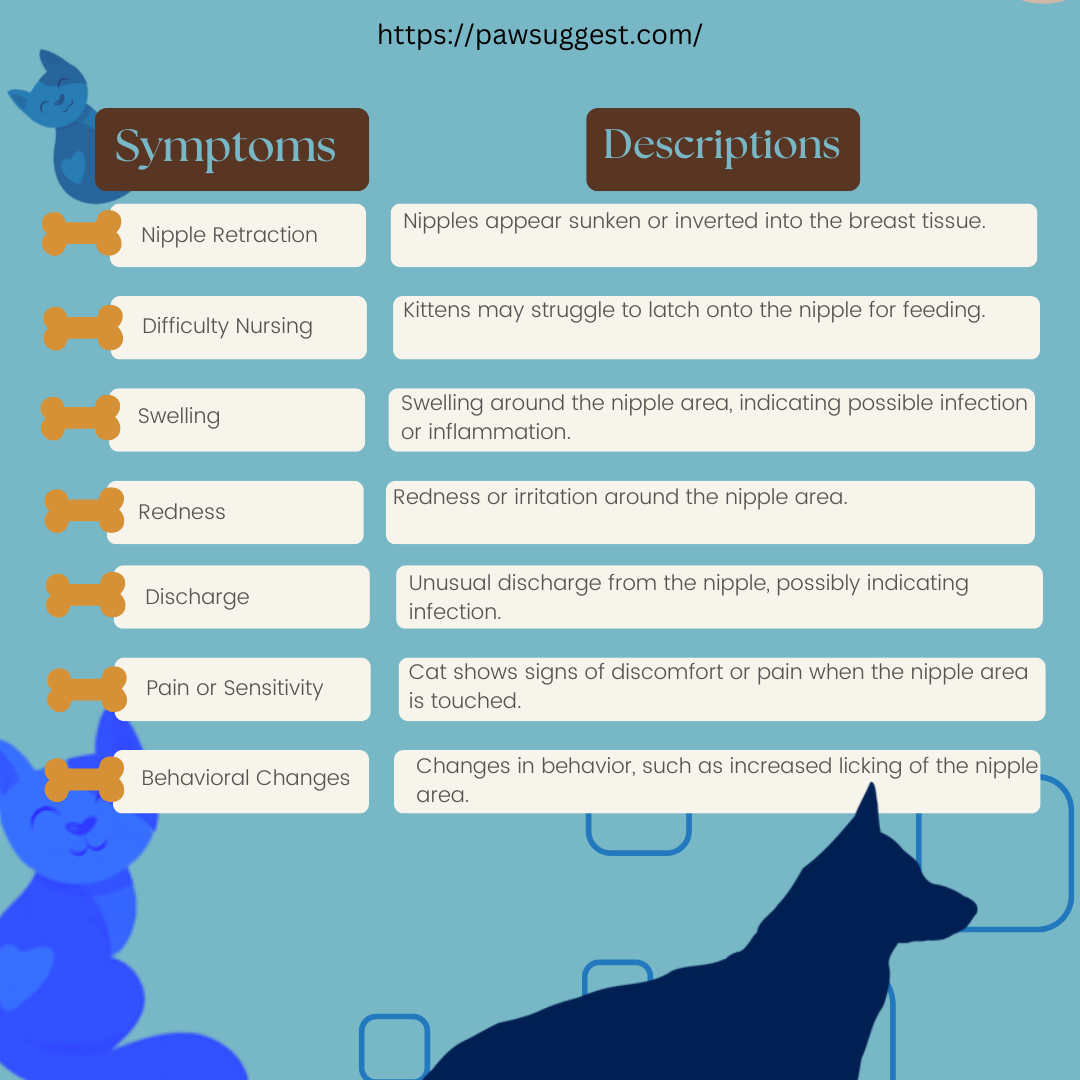Regarding our furry companions, every little detail about their health can spark concern. Among these is the curious case of inverted nipples on cats.
Even though the description of the illness and its causes may seem frightening. The way you handle it can greatly impact how long your kitty friend stays in tip-top condition.
Let’s explore this subject and learn more about cats with inverted nipples.

What Is An Inverted Nipple On Cats?
A cat’s nipples should usually stick out a little so that they are noticeable. A nipple may, however, occasionally appear retracted or sunken into the body.
Known as inverted nipples, this disorder can be caused by several issues. It includes tumors, infections, or congenital abnormalities.
The distinction between congenital and acquired reasons for inverted nipples must be made first and foremost.
Congenital conditions, which exist from birth, are often benign and do not constitute a serious health risk.
Conversely, acquired cases may arise from trauma, infections, or more serious illnesses such as mammary gland tumors.
For example, inflammation brought on by an abscess or bacterial infection in the mammary gland might cause the nipple to retract.
Therefore, early detection and diagnosis are essential to address the underlying problem.
What Causes Inverted Nipples On Cats?
Inverted nipples in cats can be caused by several factors, including:
1. Genetic Factors:
Due to genetic predispositions, certain cats may have inverted nipples from birth. The health or capacity of the cat to nurse itself is not impacted by this congenital abnormality.
2. Injury or Trauma:
Chest trauma can cause structural alterations to the nipples, including inversion. This can be the result of persistent friction or physical damage.
3. Obesity:
The nipples may occasionally retract or become less noticeable due to excess adipose tissue. It gives the appearance of being inverted.
4. Mastitis or Infection:
Nipple anatomy might change as a result of mammary gland inflammation or infection. An infection of the breast gland called mastitis can result in nipple changes, discomfort, and swelling. Meanwhile, applying silver sulfadiazine on cat’s wound can also lead to infection. So, you have to be sure that this is not the case here.
5. Hormonal Changes:
Hormonal imbalances or alterations can impact the nipples’ appearance and structure. It means those that arise during pregnancy, nursing, or hormone therapy.
6. Tumors or Growths:
Nipple inversion may result from tumors or other abnormal growths within the mammary glands. This is a more serious cause that needs to be evaluated by a veterinarian.
7. Aging:
As cats age, the skin and tissues can lose elasticity, which might result in changes to nipple appearance, including inversion.
Symptoms of Inverted Nipples On Cats
Types Of Inverted Nipples On Cats
Inverted nipples on cats can be categorized based on their appearance and the underlying causes. Here are the primary types:
Congenital Inverted Nipples:
- Description: These result from developmental abnormalities and are present from birth. Either the nipple is flat or retracts inward.
- Commonality: This is relatively rare in cats.
- Impact: Usually not a problem unless the cat is nursing, as it might affect the kitten’s ability to latch on.
Acquired Inverted Nipples:
- Description: These appear later in life and can be caused by tumors, infections, or injuries.
- Causes: Mastitis, or inflammation of the mammary glands, damage to the nipple region, and breast tumors are among the potential causes.
- Impact: This type can be more concerning, as it might indicate underlying health issues and interfere with nursing.
Treatment and Care for Inverted Nipples On Cats
For the sake of their general health, cats with inverted nipples must be treated and cared. Especially if they are nursing or pregnant.
Here’s how to efficiently manage this condition:
● Observation and Initial Steps
Above all, pay special attention to the cat’s nipples. Check them frequently for indications of inversion, such as flat or retracted inward nipples. It is imperative to take immediate action if you observe inversion.
● Gentle Massage
First, you can urge the inverted nipple to come out by gently stroking it. Applying a warm, wet towel has several advantages.
The warmth facilitates tissue relaxation, which makes nipple manipulation simpler. To urge the nipple to protrude and boost blood flow, massage the surrounding area in a circular motion.
● Lactation Aid
Next, if the cat is nursing, it may be helpful to use a lactation aid. This can include products like nipple shields or syringes designed for feeding kittens.
These tools can assist in drawing out the nipple, making it easier for the kittens to latch on.
● Hydration and Nutrition
Meanwhile, ensuring that the cat is well-hydrated and receiving proper nutrition is imperative as dehydration in cats makes things worse in this case. Good nutrition supports skin health and elasticity, which can help in managing inverted nipples.
High-quality cat food rich in essential fatty acids, vitamins, and minerals is ideal.
● Veterinary Consultation
Consulting a veterinarian is advisable if home remedies do not improve the condition. Sometimes, inverted nipples can indicate underlying health issues that need professional intervention.
The vet might recommend treatments such as topical creams or even minor surgical procedures if necessary.
● Regular Monitoring
Going forward, continuous monitoring is vital. Regularly check the nipples for any signs of infection or further inversion.
Keeping the area clean and dry is crucial to prevent bacterial growth and potential diseases.
● Encouraging Kittens to Nurse
Additionally, it can be beneficial to encourage the kittens to latch onto the inverted nipples if the cat is nursing.
With time, their sucking motion can gradually bring out the nipple. But ensure the mother cat isn’t overly stressed out or harmed by the kittens.
● Alternative Feeding
If your attempts to help the kittens latch fail, you might need to add kitten formula to their diet. As you continue to concentrate on straightening the inverted nipples, this guarantees that they get the nutrition they need.
● Preventive Care
Finally, the best course of action is preventive care. A balanced diet and routine examinations can assist in preserving the cat’s general health. It possibly averts problems like inverted nipples before they arise.
Frequently Asked Questions(FAQs)
1. Is surgery ever required to correct an inverted nipple?
In rare instances, surgical correction may be performed if the inverted nipple causes significant difficulties or discomfort.
2. Are inverted nipples painful for my cat?
Inverted nipples are usually not uncomfortable. But if your cat displays any symptoms of discomfort or if the region seems bloated and red, get in touch with your veterinarian.
3. Can inverted nipples affect my cat’s ability to nurse?
Yes, it might be difficult for kittens to nurse when they have inverted nipples. See your veterinarian if your cat is a new mother with this illness.
Final Takeaway
In conclusion, although an inverted nipple in a cat may cause some concern at first, it is typically a minor disorder.
Nevertheless, you can ensure that your feline buddy stays in excellent condition by closely monitoring any changes and seeking advice from your veterinarian.
A little knowledge goes a long way toward maintaining your furry companion’s health and happiness, as with many aspects of pet care.


